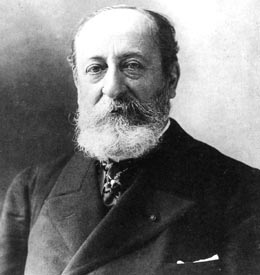Composer: Camille Saint-Saëns
- Symphony in F Major, R. 163 "Urbs Roma"
- Symphony No. 3 in C Minor, Op. 78, R. 176 "Organ"
Thierry Escaich, organ
Orchestre Philharmonique Royal de Liège
Jean-Jacques Kantorow, conductor
Date: 2021
Label: BIS
https://bis.se/conductors/kantorow-jean-jacques/saint-saens-symphonies-no3-organ-urbs-roma
https://bis.se/conductors/kantorow-jean-jacques/saint-saens-symphonies-no3-organ-urbs-roma
----------------------------------------------------------------------------
By all rights, Urbs Roma should be Saint Saëns’s Second Symphony – or even, if one counts the delightfully precocious A major work written when he was a 15-year-old student at the Paris Conservatoire, his Third. Composed in 1856 for a competition organised by Bordeaux’s Saint Cecilia Society, Urbs Roma may not be as immediately tuneful as the two published symphonies that lie just a few years to either side of it, yet in some ways it’s the most daring and imaginative. Take, for instance, the unsettling end of the opening movement, where it seems we’re hurtling towards a final cadence in D major until the last four bars, when we’re unceremoniously lurched back to the home key of F. In the slow movement, Saint-Saëns seems to be evoking the solemnity of the Marcia funebre from Beethoven’s Eroica, though he paints with macabre orchestral colours right out of Berlioz’s Symphonie fantastique. Most wondrous of all, to my ears, is the finale’s theme and variations, whose gracious warmth and rhythmic ingenuity look forward to Brahms – note the fifth variation in 5/4 time and the symphony’s quiet conclusion. Why Saint-Saëns excluded Urbs Roma when compiling his catalogue of works is difficult to fathom; surely the symphony (not published until 1974) does not deserve its neglect.
Jean Martinon was the first to record Urbs Roma (EMI, 11/75), and Jean-Jacques Kantorow followed suit in 1997 with the Tapiola Sinfonietta (BIS). Now, as part of a two-disc survey of Saint-Saëns’s five symphonies, he’s recorded it again. There are many striking things in this new account – listen, say, to the near frenzy Kantorow finds in the Scherzo, or to how sweetly the woodwinds of the Liège Royal Philharmonic sing their lyrical lines at 6'57" in the slow movement, and how the orchestra bring a sense of near weightlessness to the finale’s final minutes, so the symphony seems to float away. In general, however, I find the earlier recording more sharply focused, due in large part to the disciplined playing of the Tapiola Sinfonietta.
There are memorable moments in Kantorow’s first recording of Saint-Saëns’s Organ Symphony, too. In the transition from the first part’s Allegro moderato to the Adagio, for instance, one almost feels the change of atmosphere on one’s skin; it’s like walking from the heat of a sun-drenched street into the cool of a cathedral. I also like how stealthily organist Thierry Eschaich slips in, stepping out of the shadows, as it were. And, in fact, I’d say this performance is most compelling in the music’s softer passages – try 6'00" into track 6, where the giddiness of the Scherzo is swept away with an otherworldly hush, thanks to the ethereally delicate playing of the Liège strings. When Saint-Saëns pulls out all the stops, however, I want more power. Where’s the oomph from the brass fanfares in the finale at 1'18"? And Kantorow sounds a little clumsy in the tempo shifts at the symphony’s end. Of recent versions, I recommend Thierry Fischer’s thoughtfully detailed Hyperion release with the Utah Symphony (1/19), though my top choice remains Munch with the Boston Symphony (RCA, 11/60). Although taped in 1959, RCA’s ‘Living Stereo’ recording hardly sounds its age.
-- Andrew Farach-Colton, Gramophone
----------------------------------------------------------------------------
Camille Saint-Saëns (9 October 1835 – 16 December 1921) was a French composer, organist, conductor and pianist. Saint-Saëns was a musical prodigy, making his concert debut at the age of ten. He was a successful freelance pianist and composer, in demand in Europe and the Americas. His best-known works include his concertos, his 3rd symphony, Danse macabre and The Carnival of the Animals. Saint-Saëns was enthusiastic for the most modern music of the day, although his own compositions were generally within a conventional classical tradition. Saint-Saëns' students included Gabriel Fauré.
http://en.wikipedia.org/wiki/Camille_Saint-Sa%C3%ABns***
Jean-Jacques Kantorow (born 3 October 1945 in Cannes) is a French violin virtuoso and conductor. In the 1960s he won ten major international prizes, including first prizes in the Carl Flesch Competition (London), the (Genoa) Paganini Competition, and the Geneva International Competition. Since the 1970s he has been noted for his solo performances in a very wide range of repertoire, and as a chamber music performer. His recordings have won many awards. He plays a Stradivarius attributed violin, the ‘ex-Leopold Auer’, dated 1699. In the 1980s he began a separate career as conductor.
http://en.wikipedia.org/wiki/Jean-Jacques_Kantorow
http://en.wikipedia.org/wiki/Jean-Jacques_Kantorow
----------------------------------------------------------------------------
FLAC, tracks
Links in comment
Enjoy!



Choose one link, copy and paste it to your browser's address bar, wait a few seconds (you may need to click 'Continue' first), then click 'Free Access with Ads' / 'Get link'. Complete the steps / captchas if require.
ReplyDeleteIf you are asked to download or install anything, IGNORE, only download from file hosting site (mega.nz).
If MEGA shows 'Bandwidth Limit Exceeded' message, try to create a free account.
https://direct-link.net/610926/saint-saens-symphonies-v2
or
https://uii.io/Y2aYe0leiq
or
https://exe.io/7Esj6B
¡Muchas gracias, Ronald!
ReplyDelete